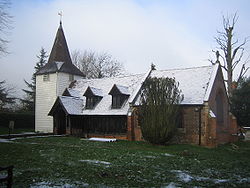Greensted-juxta-Ongar
| Greensted | |
| Essex | |
|---|---|
 Greensted Church | |
| Location | |
| Location: | 51°42’11"N, 0°13’37"E |
| Data | |
| Post town: | Ongar |
| Postcode: | CM5 |
| Dialling code: | 01277 |
| Local Government | |
| Council: | Epping Forest |
| Parliamentary constituency: |
Brentwood and Ongar |
Greensted-juxta-Ongar, more commonly known simply as Greensted, is a small village in Essex, strung out along the Greensted Road approximately one mile to the west of Chipping Ongar.
Greensted is situated in a large natural clearing, and would have been a logical place to build a settlement in the dense surrounding Epping Forest especially as it was near an existing route, the Ongar road.
Name
Greensted's full name is 'Greensted-juxta-Ongar'; a Latinized parish name maning 'Greensted adjoining Ongar', though the ful name is rarely used locally. 'Greensted' is the Old English grenestede, mening "Green Place".
Essex has another village of the name name though spelled 'Greenstead', in Colchester.
History
Greensted is important because of its longevity: the parish has existed since Anglo-Saxon times and a striking witness to those times stands in the heart of the viullage: its wooden parish church, believed to be the oldesrt wooden church in the world. It often seems as if little has changed in Greensted since those days.
Parish church
The parish church is St Andrew's, commonly known as Greensted Church. This is a famous church; small and out of the way, but apparently the oldest wooden church in the world. It was featured on a British postage stamp issued in April 1972.[1]
The east end, of brick construction, dates from the sixteenth century, while the brick footings, visible below the timber walls, are a feature of extensive restoration undertaken in the nineteenth century. The main body of the church however is an Anglo-Saxon wooden church in which the walls are built of vertical half tree trunks, the planed flat surfaces within and the round outer surfaces outside.
See also
Outside links
References
- ↑ Stanley Gibbons Stamp Catalogue (1982), Part 1: British Commonwealth. London: Stanley Gibbons Publications Ltd., p GB 24.